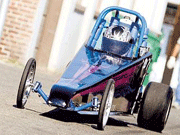
Drag Racer (Junior Dragster)

Junior Dragsters (or Junior Drag Racers) are ½ scale versions of top fuel dragsters. They offer children 6 years and older an opportunity to get into drag racing (5 year olds can join a training class). The class has become very popular as a family racing opportunity and also as a training ground for stepping up to higher level drag series.
Junior dragsters are characterized by their scratch-built single seat chassis, mid-engine (that is, between the driver and rear tires) rear-drive layout and covering bodywork. A roll cage is integral to provide safety for the driver. The base class uses a 5 horsepower motor, with higher horsepower used for classes for older children.
The chassis is relatively easy to construct and repair and the engine is reasonably low cost to maintain.
Racing is held on local drag strips and is run in the USA, Canada and the UK.
Drag Racer (Junior Dragster) Contents
| Power and Weight Stats | |
| Horsepower (Typical Range) | 5-5 |
| Race Weight (Typical Range) | 136-204 kg 300-450 lb |
Design and Construction
Race Car Models of This Type
Junior Dragster and Junior Comp are the two present models.
Build Your Own Junior Dragster
Knowledge Level
Due to the scratch-built nature of Junior dragsters, the builder will find working knowledge in handling, chassis, suspension, powertrain, aerodynamic and safety useful. More advanced knowledge in these six major areas of the car design may help the designer optimize the traction and performance of the car, but due to restrictions placed on E.T. (Elapsed time) and speed limits, there is intended to be a performance cap to prevent excessive development. Still, the opportunity exists to maximize performance within the limits imposed.
Design Challenges
Weight Distribution: Weight transfer to the rear tires upon launch is critical in drag racing. The greater the weight transferred the better. However, the front tires must continue to provide steering capability.
Suspension: Suspension, within the rules should permit maximum weight transfer to the rear tires and remain compliant to the road surface. The suspension pickup point locations impact the chassis design.
Chassis: Some flex in the chassis will assist in weight transfer to rear tires on launch.
Powertrain: Weight distribution is heavily impacted by engine position. In drag racing, maximum weight transfer is achieved with the highest CG (vertically), and the mass close as possible (rearward) toward the tire contact patch. In drag racer design there are practical and potentially regulation limits to locating the engine and driver, and wheelie bars become important as flipping becomes more and more possible with rearward CG.
Aerodynamic: Given the speeds of base 5 horsepower Junior Dragsters, aero devices like wings are not likely a factor in performance, except as a source of drag. Even in higher powered Junior machines, wheel spin is not significant at speeds where the downforce generated by a wing would overcome the penalty in drag.
Safety: Providing a substantial crash/rollover safety cell for the driver is vital along with a racing seat/harness. Protection for fuel storage, fire protection.
If you intend to race under a sanctioning body, always read and understand the regulations of your chosen racing class before designing or building any race vehicle.
Design Resources
Learn the basics about race cars and race car design from our free online knowledge series
Download our free race car design aids to assist you designing your race vehicle.
In-depth books and learning resources we recommend for junior dragster design.
Join our forum to ask and find answers to your junior dragster design/construction questions.
Construction Challenges
If constructing your own chassis, ensure the chassis is dimensionally accurate and straight. The use of a solid, flat and level build space is important. Jigs are often used in this case to ensure that structural tubing stays in alignment during welding/brazing.
The builder should have solid joining and metal working knowledge and skills when fabricating the chassis/rollcage/suspension. While mild steel (1018/1020) is very forgiving, some metals are best welded using a specific method (mig/tig) and some require heat treatments before and following welding to restore their toughness and strength.
Having sufficient space for the chassis construction is important, as a cramped workshop can be difficult to work in.
The tools to fabricate the chassis and bodywork can add considerably to the cost of your project if you don't already have a workshop, but borrowing or renting items is also an option.
Build Costs
Most components can be purchased off-the-shelf as there is an industry of parts manufacturers for Junior dragsters. These parts reduce the cost of the overall machine when compared to fabricating your own. Entire chassis can also be purchased if an assembly-only project is preferred.
Build Effort
Depending on the approach you prefer, you can either purchase a pre-fabricated chassis and assemble your car (kit), or design and optimize your own chassis (from scratch)
If scratch building, there can be significant effort in design and construction when compared to purchasing a kit and assembling. There is however, an equally great satisfaction and sense of accomplishment at being one of the few people in the world who have built their own race car from the ground up!
Racing Cost
Consumable costs low—Tires probably form the single largest consumable expense. Engine rebuilds and repairs are periodic.
Transportation and Support Equipment
Trailering required.

